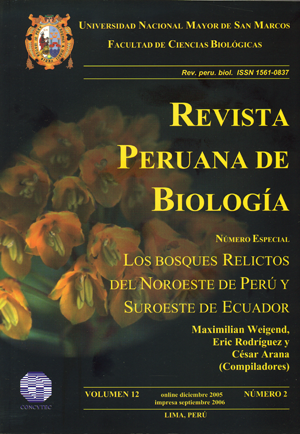Podocarpaceae of the montane forests from northwestern Peru
DOI:
https://doi.org/10.15381/rpb.v12i2.2400Keywords:
Podocarpus, Podocarpaceae, Montane Forests, Nageia, North-western PeruAbstract
The montane forests of north-western Peru are plant formations with high biodiversity and numerous endemic taxa. Unfortunately, in many places, they are deteriorated by deforestation and colonization processes, to turning into one of the most threatened ecosystems of the world. At the present, montane forests are reduced to isolated fragments. The relict forests are distributed above 1000 m on the western slope of the Andes. These forests are habitat for Peruvian native coniferous of the Podocarpaceae family. These species are supporting the fragility of montane forests ecosystems, however they are being cut down in large numbers because of the excellent timber quality. There are some forests largely dominated by Podocarpaceae in north-western Peru, we have the Cachil forest (Cajamarca, Province Contumazá) and Tongod-Quellahorco (Cajamarca, Province San Miguel) which are dominated by Podocarpus oleifolius. The San Ignacio forests (Cajamarca, Province San Ignacio) where we find half the species known from Peru, there are five species from three genera: Podocarpus oleifolius, P. macrostachys, P. sprucei, Prumnopitys harmsiana and Nageia rospigliosii.Downloads
Downloads
Published
Issue
Section
License
Copyright (c) 2005 Edgar E. Vicuña-Miñano

This work is licensed under a Creative Commons Attribution-NonCommercial-ShareAlike 4.0 International License.
AUTHORS RETAIN THEIR RIGHTS:
a. Authors retain their trade mark rights and patent, and also on any process or procedure described in the article.
b. Authors retain their right to share, copy, distribute, perform and publicly communicate their article (eg, to place their article in an institutional repository or publish it in a book), with an acknowledgment of its initial publication in the Revista Peruana de Biologia.
c. Authors retain theirs right to make a subsequent publication of their work, to use the article or any part thereof (eg a compilation of his papers, lecture notes, thesis, or a book), always indicating its initial publication in the Revista Peruana de Biologia (the originator of the work, journal, volume, number and date).






